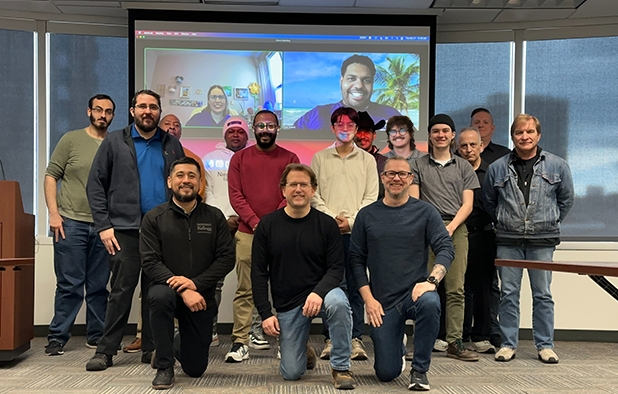Colleague Connection: Navigators of Northwestern’s Digital Landscape
The sheer number of endpoints used on campus requires innovative endpoint management solutions to streamline operations, enforce security protocols, and ensure seamless connectivity to Northwestern’s network and services. We checked in with Scott Terry, manager of Endpoint Device Management (EDM), to learn more about his teams and their pivotal role in navigating Northwestern’s digital ecosystem.
What services does EDM provide?
EDM is a unit within Technology Support Services that offers central support for everything related to end-user computing. Endpoints we support include computers, peripherals (docking station, mouse, keyboard, webcam, monitors, headsets), and printers. We also support Jabber, the University’s softphone client (but not the phones) and manage the backend platform management tools.
 Schools and departments opt-in for our service. Our customers include Weinberg College (faculty and staff), which makes up most of the 3,200 computers we manage, and a mix of about 70 other departments and organizations across Northwestern that don’t have in-house IT support. And, of course, we support end-user computing for Northwestern IT!
Schools and departments opt-in for our service. Our customers include Weinberg College (faculty and staff), which makes up most of the 3,200 computers we manage, and a mix of about 70 other departments and organizations across Northwestern that don’t have in-house IT support. And, of course, we support end-user computing for Northwestern IT!
Additionally, we are the first line of support for troubleshooting equipment connectivity in IT-managed conference rooms and partner with Media and Technology Innovation to escalate support issues as necessary. There are endpoints in some labs that we support, too.
Who are the teams within EDM?
EDM has two teams, each with unique roles. Our three system administrators focus on supporting backend platforms–such as KACE and MECM (Windows), JAMF (Mac), and CrashPlan—tools that manage endpoints directly.
Several of these platforms collect hardware and software inventory, allowing us to deploy software, perform imaging, and push monthly security patches to our client’s machines. For example, while KACE is considered a central service, it is also used by 16 organizations outside of IT. This team is responsible for responding to issues and working with the vendor to triage and resolve them.
The system administrators also oversee and manage our CrowdStrike tenant, which alerts us to security vulnerabilities from an endpoint. Generally, most of the security alerts we receive are for someone trying to download an unapproved application. But there have been times when malware is detected on a machine. Depending on the severity of the attack, we can isolate the machine with CrowdStrike until we can triage the issue. However, when a critical vulnerability is discovered, the support side of our team takes over. We escalate to the Information Security Office when the malware threat is potentially widespread.
Our support team includes two leads and 11 dedicated field technicians; one focuses on executive support (Office of the President, Office of the Provost, Board of Trustees, and other executive leaders), while the other oversees field operations. Most of our customers are on the Evanston campus, but a few are on the Chicago campus, and we plan visits to support them when needed.
We have established support zones on the Evanston campus, and team members work out of support hubs embedded in the various support zones. These hubs can be a single cube or an office. For example, our North Zone hub is in the Kellogg Global Hub and is embedded with the Weinberg Economics department. Because of that geo-location, the person staffing the hub is the closest to supporting other customers within that zone.
Team members move around campus daily to meet customers and resolve technical issues. I like to say that we are the face of IT. However, when an in-person meeting isn't convenient for our customers based on their location or availability, we can connect with them using remote support services such as Bomgar.
What are some of the unique aspects of EDM’s daily work?
We are designed to be generalists from a support perspective and encounter many interesting technical problems. We don’t necessarily solve every problem, but we are the conduit to solving it. We engage the customer and help facilitate a solution. For example, we don’t manage a port but know who does and can escalate to the appropriate team.
One challenge is the variety of technical issues. We need to be resourceful, technically curious, and troubleshoot to pinpoint the issue and know the right IT team to escalate it. ”
Manager, Endpoint Device Management
One challenge is the variety of technical issues. Sixty percent of what we see are general how-to or standard application issues. The other 40 percent may be something we haven’t seen before. We need to be resourceful, technically curious, and troubleshoot to pinpoint the issue and know the right IT team to escalate it. In addition, we do a lot of research on our own, trial and error, and troubleshooting to resolve our customer issues.
What is your favorite place on campus?
Someone introduced me to the Shakespeare Garden. I always try to make a point of going there in late spring/early summer. You can even take a meeting from that location because eduroam is really strong there! I also enjoy walking along the lakefront towards the Kellogg Global Hub.